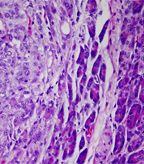Epigenetic Change in DNA Structure May Serve as Marker for Melanoma
A new epigenetic hallmark of melanoma has been identified, which has a critical function in disease development, and may serve as a potential target for reversing melanoma progression.
A new epigenetic hallmark of melanoma has been identified, which has a critical function in disease development, and may serve as a potential target for reversing melanoma progression, according to the results of a recently published study.

Micrograph of metastatic melanoma cells, left, that have invaded pancreatic tissue, right
Prior research has identified abnormal DNA methylation at the 5 position of cytosine (5-mc) as a well-known epigenetic feature of cancer; however, no specific markers have been identified as a marker for melanoma.
Using genome-wide mapping, George F. Murphy, MD, professor of pathology, Harvard Medical School, and colleagues found that the 5-hydroxymethylcytosine (5-hmC) may serve a key function in melanoma suppression and that loss of 5-hmC may be an epigenetic indicator of malignant melanoma. The results of the study were published in Cell.
In the study, a sample of more than 50 unique cases of melanoma-including benign nevi, primary, and metastatic melanomas-were examined and found to have partial or complete loss of 5-hmC. When levels of 5-hmC were compared, the researchers found that nevi had higher levels of 5-hmC compared with melanomas, which had diminished or complete loss of the marker.
“What is exciting about the finding is that, unlike a mutation, which changes the permanent genetic DNA structure, loss of this tag-5-hmC-is potentially reversible,” Murphy said. “In fact, in our study we were able to demonstrate that melanoma growth in mouse and fish models could actually be slowed by restoring the 5-hmC tag to the DNA.”
Next, the researchers sought to determine what cellular factors were responsible for the loss of 5-hmC. They discovered one mechanism of the loss was the downregulation of two enzymes: isocitrate dehydrogenase 2 (IDH2) and the ten-eleven translocation (TET) family enzymes.
Using fish and mouse xenograft models, Murphy and colleagues reintroduced active IDH2 and TET2, which was shown to decrease tumor proliferation and growth, and improve tumor-free survival.
“Taken together, the present study provides multiple layers of evidence to support that genome-wide loss of 5-hmC is a new epigenetic hallmark of melanoma, with diagnostic and prognostic advantages over global DNA hypomethylation, a recognized epigenetic mark of cancer,” the researchers wrote in their discussion. “Of clinical and therapeutic significance, the present study also opens a new avenue for cancer prevention by targeting the cellular and biochemical pathways that can re-establish 5-hmC levels and landscape in melanoma.”
Murphy said that such findings, while exciting, require more testing to be brought to the bedside.
“But because there currently are few effective treatments for advanced melanoma, this study opens up a promising new area for melanoma investigation,” Murphy added. “In addition, because markers using the microscope are limited for recognizing the more difficult melanomas, loss of the 5-hmC tag may also prove to have diagnostic value.”
Newsletter
Stay up to date on recent advances in the multidisciplinary approach to cancer.